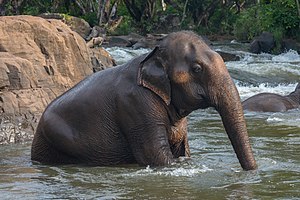Elephant

Elephants are the largest land animals in existence. Currently, three living species are recognized: the African bush elephant, the African forest elephant, and the Asian elephant. They are the only surviving members of the Elephantidae family and the Proboscidea order. In the past, the order had much greater diversity during the Pleistocene, but most species became extinct in the Late Pleistocene epoch.
Elephants possess distinctive features such as a long proboscis called a trunk, tusks, large ear flaps, pillar-like legs, and tough but sensitive skin. The trunk is a versatile tool used for breathing, bringing food and water to the mouth, and grasping objects. Tusks, derived from the incisor teeth, serve as both weapons and tools for moving objects and digging. The large ear flaps help regulate body temperature and aid in communication. African elephants have larger ears and concave backs, while Asian elephants have smaller ears and convex or level backs.
Elephants are found across sub-Saharan Africa, South Asia, and Southeast Asia, inhabiting various habitats including savannahs, forests, deserts, and marshes. They are herbivorous and tend to stay near accessible water sources. Considered keystone species, elephants have a significant impact on their environments. They have a fission-fusion society, where multiple family groups come together to socialize. Female elephants (cows) typically live in family groups, which can consist of a single female with her calves or multiple related females with offspring. These groups, led by the oldest female known as the matriarch, do not include males (bulls).
Male elephants (bulls) leave their family groups upon reaching puberty and may live alone or with other males. Adult bulls primarily interact with family groups when seeking a mate. During this time, they undergo a period of increased testosterone and aggression called musth, which helps them establish dominance over other males and achieve reproductive success. Calves are the focal point within their family groups and rely on their mothers for up to three years. In the wild, elephants can live up to 70 years. They communicate through touch, sight, smell, and sound, utilizing infrasound and seismic communication over long distances. Elephant intelligence has been compared to that of primates and cetaceans. They display self-awareness and exhibit empathy towards dying and deceased family members.
The African bush elephant and Asian elephant are listed as endangered, while the African forest elephant is classified as Critically Endangered by the International Union for Conservation of Nature (IUCN). The ivory trade poses one of the most significant threats to elephant populations, as these animals are poached for their tusks. Other threats include habitat destruction and conflicts with local communities. Elephants are also used as working animals in Asia. In the past, they were employed in warfare.
See also
- The effects of captivity on elephants
- Elephant tourism
- List of living captive elephants
- List of captive elephant deaths
- Bullhooks
- Phajaan
- An Apology to Elephants - film
External links
- Elephant Wikipedia
- Elephas maximus Wikispecies
